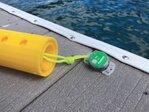

LAKE CHELAN - Known for its beauty and pristine waters, Lake Chelan is the pride of the community and Washington’s largest natural lake. Home to fishing, boating, swimming and other activities, the lake is a recreational staple for residents and tourists alike. The third deepest lake in the United States, it boasts 52 square miles of total surface area while the entire watershed encompasses about 920 square miles.
Yet over the past decades, changes such as increased population, substantial development and changing land use have threatened the lake’s overall health. Another prominent threat is the increased presence of invasive plant species.
Enter the Lake Chelan Research Institute. Formed in 2016, the organization gathers data on basic water quality parameters. From 2007-2016, there were no water quality measurements taken from Lake Chelan. The LCRI seeks to collect and measure water quality data in order to monitor and make improvements to the lake, particularly in the area of invasive plant species. In August and September of 2021, the Aquatic Invasive Species Survey mapped 520 acres of nonnative plants, primarily Eurasian Water Milfoil and Curly Leaf Pondweed. These weeds, especially prominent in the Wapato Basin and lower Lucerne Basin, increased significantly from a survey taken eight years ago. The research also revealed a presence of invasive freshwater clams (corbicula fluminea).
“We’ve been focused on making sure that we now do monthly sampling in three locations and we do multi-parameter probe measurement at several locations in the lake,” said Phil Long, LCRI executive director.
Those three locations include one in the middle of the lake across from Lakeside Park, another halfway between Lake Chelan State Park and Willow Point Park, and a third in the lower Lucerne Basin opposite of where Stink Creek flows into the lake.
When taking water samples from Lake Chelan, there are two types of data the LCRI collects. First, they gather field parameters at the time they are on the site. Using instruments, including a multi-parameter probe, they amass various data such as water temperature, electrical conductivity, pH (Potential of Hydrogen) levels, chlorophyll levels, blue-green algae concentration and fluidity.
Next, they lower a second disc into the lake to track when it disappears as a measure of water clarity. They then collect water samples that technicians analyze at the Flathead Lake Biological Station in Polson, MT for parameters of interest including total nitrogen, nitrate, nitrite and total phosphorus. Long hopes to keep the phosphorus level below 4.5 micrograms per liter, which he said is currently the case in the middle of the lake. Overall, Long said the bulk water in the lake looked pretty good. However, he did find some bad news.
“Pretty much universally, people talk about the fact that there’s more green stuff growing on the rocks and the sentiment in those margins of the lake,” Long said, referring to paraphyte. “We have some waterfront owners who have reported that prior to 2021, they didn’t seen any attached green algae growing to their bulkhead or to their dock, whereas in 2021 they saw it for the first time.”
A likely contributing factor to paraphyte growth is increased water temperature, which Long realized was a gap in his data. Thanks to the Icicle Fund in Leavenworth, the LCRI landed a grant to measure water temperature in Lake Chelan for an extended period, perhaps ten years. The LCRI is now looking at 8-10 sites to measure lake temperatures, primarily in Chelan’s Wapato Basin with a few in the Lucerne Basin. Specifically, the institute wants to monitor inshore waters which it can do by suspending temperature loggers off waterfront home docks or buoys. The institute has contacted local homeowners for this project, receiving a positive response.
“That’s part of our project to get some citizen science going and get interest in Lake Chelan Research Institute by people who have waterfront homes so that’s a big driver for us,” Long said.
The more information the LCRI can attain, the more they can study Lake Chelan and take measures to protect it.
“I am grateful that we’re starting to get more data on this lake, because there’s been a lack of it for so long,” said Bella Gatzemeier, environmental project coordinator.
Another potential solution LCRI will be testing is Diver Assisted Suction Harvesting (DASH). This process entails sending scuba divers into the lake to identify invasive plants, pull them up by the roots and place them into suction tubes for transportation into a boat. DASH is a trial balloon of sorts to discern how much it would cost to take this action on a larger level and gather crucial information on inshore waters.
“It’s where people experience the lake, where they get their feet tangled up in milfoil if that happens, heaven forbid,” Long said. “I do have a friend who says that his kids won’t go to certain areas to swim in the lake because they can feel the milfoil tickling their toes and they don’t like it, so that’s the existential threat to tourism in Lake Chelan.”
As the institute continues to gather crucial data, atop Long’s priority list is to discover what has led to the increased growth of attached green algae.
“We think it’s more complicated than just temperature, but unless we have the temperature data, we don’t know where we’re at,” he said. “The key is, what do we need to do as a community to maintain this nearshore water quality so that people, everybody, can continue to enjoy the lake, residents and visitors alike?”
The LCRI works closely with the Chelan County Natural Resources Department. Funding for the institute comes mostly from local organizations including the City of Chelan, Chelan County, Lake Chelan Reclamation District, Cascadia Conservation District and Chelan County Public Utility District.
For more information about the Lake Chelan Research Institute, contact Phil Long at phillong@nwinet.
Comments
No comments on this item Please log in to comment by clicking here